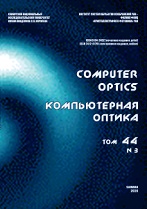|
This article is cited in 2 scientific papers (total in 2 papers)
NUMERICAL METHODS AND DATA ANALYSIS
Building a noise-tolerant code based on a holographic representation of arbitrary digital information
A. L. Timofeev, A. Kh. Sultanov
Ufa State Aviation Technical University, 450008, Russia, Ufa, K. Marks Street, 12
Abstract:
The article considers a method of error-correcting coding based on the holographic representation of a digital signal. The message encoding process is a mathematical simulation of a hologram created in virtual space by a wave from an input signal source. The code word is a hologram of a point, it is also a one-dimensional zone ruler that carries information about the input data block in the form of an n-bit code of the coordinate of the center of the Fresnel zones. It is shown that the holographic representation of the signal has significantly greater noise immunity and allows you to restore the original digital combination when most of the code message is lost and when the encoded signal is distorted by noise several times higher than the signal level. To assess the noise immunity, the reliability of information transmission over the channel with additive white Gaussian noise is compared using the Reed-Solomon code, the Reed-Muller code, the majority code, and the holographic code. The comparative efficiency of codes in the presence of packet errors caused by the effect of fading due to multipath propagation in radio channels is considered. It is shown that holographic coding provides the correction of packet errors regardless of the length of the packet and its location in the codeword. The holographic code is of interest for transmitting information over channels with a low signal-to-noise ratio (space communications and optical communication systems using free space as a transmission channel, terrestrial, including mobile radio communications), as well as for storing information in systems exposed to ionizing radiation.
Keywords:
digital holography, computer holography, diffraction optics, noise-resistant coding.
Received: 17.04.2020
Accepted: 02.10.2020
Citation:
A. L. Timofeev, A. Kh. Sultanov, “Building a noise-tolerant code based on a holographic representation of arbitrary digital information”, Computer Optics, 44:6 (2020), 978–984
Linking options:
https://www.mathnet.ru/eng/co872 https://www.mathnet.ru/eng/co/v44/i6/p978
|

| Statistics & downloads: |
| Abstract page: | 115 | | Full-text PDF : | 37 | | References: | 18 |
|




 Contact us:
Contact us: Terms of Use
Terms of Use
 Registration to the website
Registration to the website Logotypes
Logotypes








 Citation in format
Citation in format 
